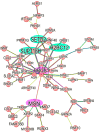Proteomic Analysis of Invasive Breast Cancer Cells Treated with CBD Reveals Proteins Associated with the Reversal of Their Epithelial-Mesenchymal Transition Induced by IL-1β
- PMID: 40429863
- PMCID: PMC12111826
- DOI: 10.3390/ijms26104721
Proteomic Analysis of Invasive Breast Cancer Cells Treated with CBD Reveals Proteins Associated with the Reversal of Their Epithelial-Mesenchymal Transition Induced by IL-1β
Abstract
Cannabidiol (CBD) has shown promise in treating cancers with an inflammatory microenvironment. Although it has been demonstrated that IL-1β induces epithelial-mesenchymal transition (EMT) of MCF-7 cells and CBD reverts this process, in restoring the epithelial non-invasive phenotype, there is limited understanding of how this cannabinoid regulates these processes. In this work, MCF-7 cells were induced to adopt an aggressive phenotype (6D cells), which was reversed by CBD. Then, protein expression was analyzed by mass spectrometry to compare 6D vs. MCF-7 cells and 6D+CBD vs. 6D cells proteomes. Novel proteins associated with EMT and CBD signaling were identified. Twenty-four of them were oppositely regulated by IL-1β and CBD, suggesting new points of crosstalk between the IL-1β and CBD signaling pathways. From the data, two protein networks were constructed: one related to EMT with 58 up-regulated proteins and another with 21 related to CBD signaling. The first one showed the proteins BRCA1, MSN, and CORO1A as the key axis that contributes to the establishment of a mesenchymal phenotype. In the CBD signaling, the key axis was formed by SUPT16H, SETD2, and H2BC12, which suggests epigenetic regulation by CBD in the restoration of an epithelial phenotype of breast cancer cells, providing new targets for anticancer therapy.
Keywords: cancer treatment; cannabidiol; mass spectrometry; phenotype reversion; protein networks; protein regulation; proteomics.
Conflict of interest statement
The authors declare no conflicts of interest.
Figures






Similar articles
-
CBD Reverts the Mesenchymal Invasive Phenotype of Breast Cancer Cells Induced by the Inflammatory Cytokine IL-1β.Int J Mol Sci. 2020 Mar 31;21(7):2429. doi: 10.3390/ijms21072429. Int J Mol Sci. 2020. PMID: 32244518 Free PMC article.
-
CBD Inhibits In Vivo Development of Human Breast Cancer Tumors.Int J Mol Sci. 2023 Aug 26;24(17):13235. doi: 10.3390/ijms241713235. Int J Mol Sci. 2023. PMID: 37686042 Free PMC article.
-
Proteomic Analysis of Epithelial to Mesenchymal Transition (EMT) Reveals Cross-talk between SNAIL and HDAC1 Proteins in Breast Cancer Cells.Mol Cell Proteomics. 2016 Mar;15(3):906-17. doi: 10.1074/mcp.M115.052910. Epub 2016 Jan 13. Mol Cell Proteomics. 2016. PMID: 26764010 Free PMC article.
-
Cannabidiol as a novel therapeutic agent in breast cancer: evidence from literature.BMC Cancer. 2025 Apr 24;25(1):772. doi: 10.1186/s12885-025-14175-z. BMC Cancer. 2025. PMID: 40275168 Free PMC article.
-
Polyphenols Modulating Effects of PD-L1/PD-1 Checkpoint and EMT-Mediated PD-L1 Overexpression in Breast Cancer.Nutrients. 2021 May 19;13(5):1718. doi: 10.3390/nu13051718. Nutrients. 2021. PMID: 34069461 Free PMC article. Review.
References
-
- Guttilla Reed I. Mechanism and Regulation of Epithelial-Mesenchymal Transition in Cancer. Cell Health Cytoskelet. 2015;7:155. doi: 10.2147/CHC.S73822. - DOI
-
- Mendoza-Rodríguez M., Ayala-Sumuano J., García-Morales L., Zamudio-Meza H., Pérez-Yepez E., Meza I. IL-1β Inflammatory Cytokine-Induced TP63 Isoform ∆NP63α Signaling Cascade Contributes to Cisplatin Resistance in Human Breast Cancer Cells. Int. J. Mol. Sci. 2019;20:270. doi: 10.3390/ijms20020270. - DOI - PMC - PubMed
MeSH terms
Substances
Grants and funding
LinkOut - more resources
Full Text Sources
Medical
Research Materials
Miscellaneous

